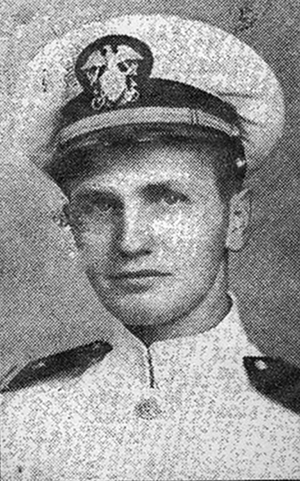

Remember...
James Paul Angelo
1914-1943
"Today we may say aloud before an awe-struck world: 'We are still masters of our fate. We are still captain of our souls."
British Prime Minister Winston Churchill
Ensign James Paul Angelo was born on March 7, 1914, at Eagle in Fayette County, West Virginia. Church records show he was baptized at Sacred Heart Church on March 23, 1914, in Charleston, West Virginia. He was the son of Andrew Ferris ("Andy") Angelo (1885-1973) and Nina Catherine Lee Angelo (1893-1924). According to his great-niece Donna Angelo Mowrey, James had three brothers: Lewis Edward Angelo Sr. (1907-1973), Walter Lee Angelo (1909-1992), and Charles Andrew Angelo (1919-1994). Two other siblings died at birth: Gertrude Marie Angelo (October 22, 1922) and Francis Angelo (August 24, 1924). Nina Catherine died on that same day, and she and her youngest son are buried together in the same casket at Mt. Olivet Cemetery in Charleston, Kanawha County, West Virginia. After Nina's death, Andy was remarried to Lucy Mae Hudnall Angelo.
James grew up in Charleston, where the family lived on Goshorn Street. He graduated from Charleston Catholic High School, Georgetown University, and Cornell University. At the time he entered the service in 1942, he was employed with the U.S. State Department. He entered the service from the state of Virginia because he was living in Arlington at the time. On February 22, 1941, he married Louise Christine Cowie Angelo in the Church of Saint Ann in Washington, D.C. In the U.S. Navy, he was commissioned as an ensign.
A "presumed dead" notice in the Charleston Gazette on September 18, 1944, notes that James had been stationed with the Spars at Fort Lauderdale, Florida. But on the night of August 18/19, 1943, Ensign Angelo was the officer in charge of an armed guard crew aboard the tanker MS J. H. Senior, a merchant marine ship, in a convoy of 64 ships. The J. H. Senior had an interesting history; part of the Panama Transport Company tanker fleet, she was manned by German crews until the day before the Nazis invaded Poland. On August 30. 1939, and the day following, at Newport News, Virginia, the German crew was taken off and replaced by an American crew. (In 1942, it was replaced by a Danish crew.) On August 14, 1943, she left New York for the United Kingdom with a full cargo of gasoline, a deck cargo of airplane fuselages, and 21 cases of airplane wings. Manned by a Danish crew of 46 officers and men, the J. H. Senior carried a U.S. Navy gun crew of 28 - an officer and 27 enlisted men. That officer was Ensign James Paul Angelo.
In foggy conditions, about 600 miles east of Halifax, Nova Scotia, the J. H. Senior collided with the American freighter SS J. Pinckney Henderson, the cargo of which was highly flammable. Both vessels caught fire and were gutted. The incident was considered a "friendly" event. All but nine men of both vessels were lost, but the ships themselves were towed with the intent of reconditioning them. The J. H. Senior was first towed to St. Johns, Newfoundland, then to Halifax, and then to New York. ("Heavy Fire Loss," Auke Visser's International Esso Tankers Site, accessed 16 March 2021, http://www.aukevisser.nl/inter/id1184.htm.) After reconditioning, she remained in service until 1950.
The Henderson, which was on her maiden voyage, however, was towed to Nova Scotia, where she was beached and allowed to burn herself out. She was declared a constructional total loss and was scrapped at Philadelphia in July 1944. ("SS J. Pinckney Henderson [+1943]," Wrecksite, accessed 19 March 2021, https://www.wrecksite.eu/wreck.aspx?237206.)
Ensign Angelo's commendations include the World War II Victory Medal, the Purple Heart, the Combat Action Ribbon, the American Campaign Medal, the Navy Presidential Unit Citation, the Navy Good Conduct Medal, and the Navy Expeditionary Medal.
Article prepared by Patricia Richards McClure, who gratefully acknowledges the contributions of James Paul Angelo's great-niece Donna Angelo Mowrey
March 2021

West Virginia Archives and History welcomes any additional information that can be provided about these veterans, including photographs, family names, letters and other relevant personal history.